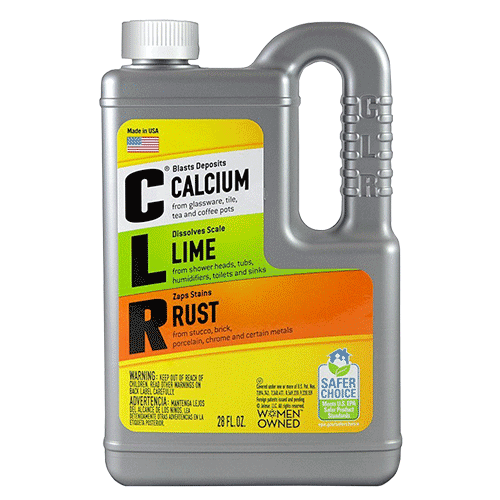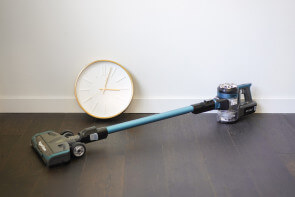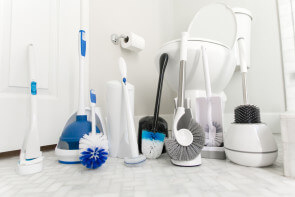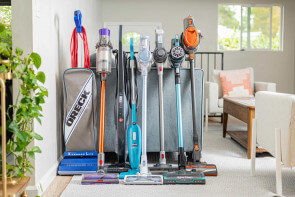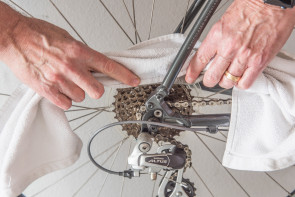
The Best Rust Removers
We spent three days testing six of the top rust removers on the market on a variety of rusted tools, household objects and doors to determine which was superior. Ultimately, we selected Iron Out – Stain Remover as the best rust remover. Iron Out is simple to apply in spray-gel form, acts quickly, and for some surfaces — like rusted chrome — works to restore products to almost showroom condition. Our runner-up is CLR – Calcium Lime Rust Remover.
We spent three days testing six of the top rust removers on the market on a variety of rusted tools, household objects and doors to determine which was superior. Ultimately, we selected Iron Out – Stain Remover as the best rust remover. Iron Out is simple to apply in spray-gel form, acts quickly, and for some surfaces — like rusted chrome — works to restore products to almost showroom condition. Our runner-up is CLR – Calcium Lime Rust Remover.
Table of contents
- The 6 rust removers we tested
- Best overall: Iron Out – Stain Remover
- Also great: CLR
- Other products we tested
- How we selected
- How we tested
- Types of rust
- Common methods for removal
- Important features to consider
- The bottom line
The 6 rust removers we tested
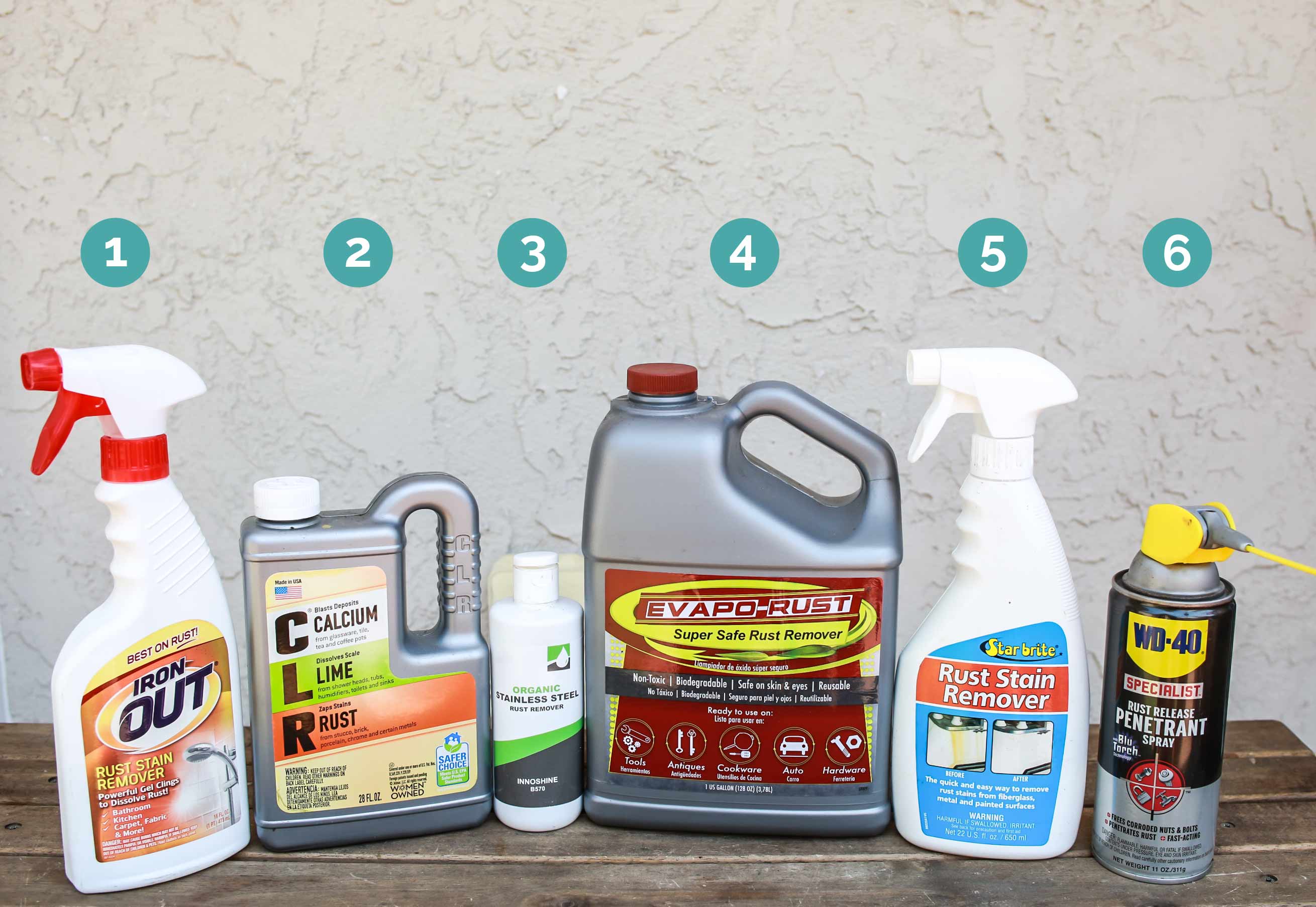
Best overall: Iron Out – Stain Remover
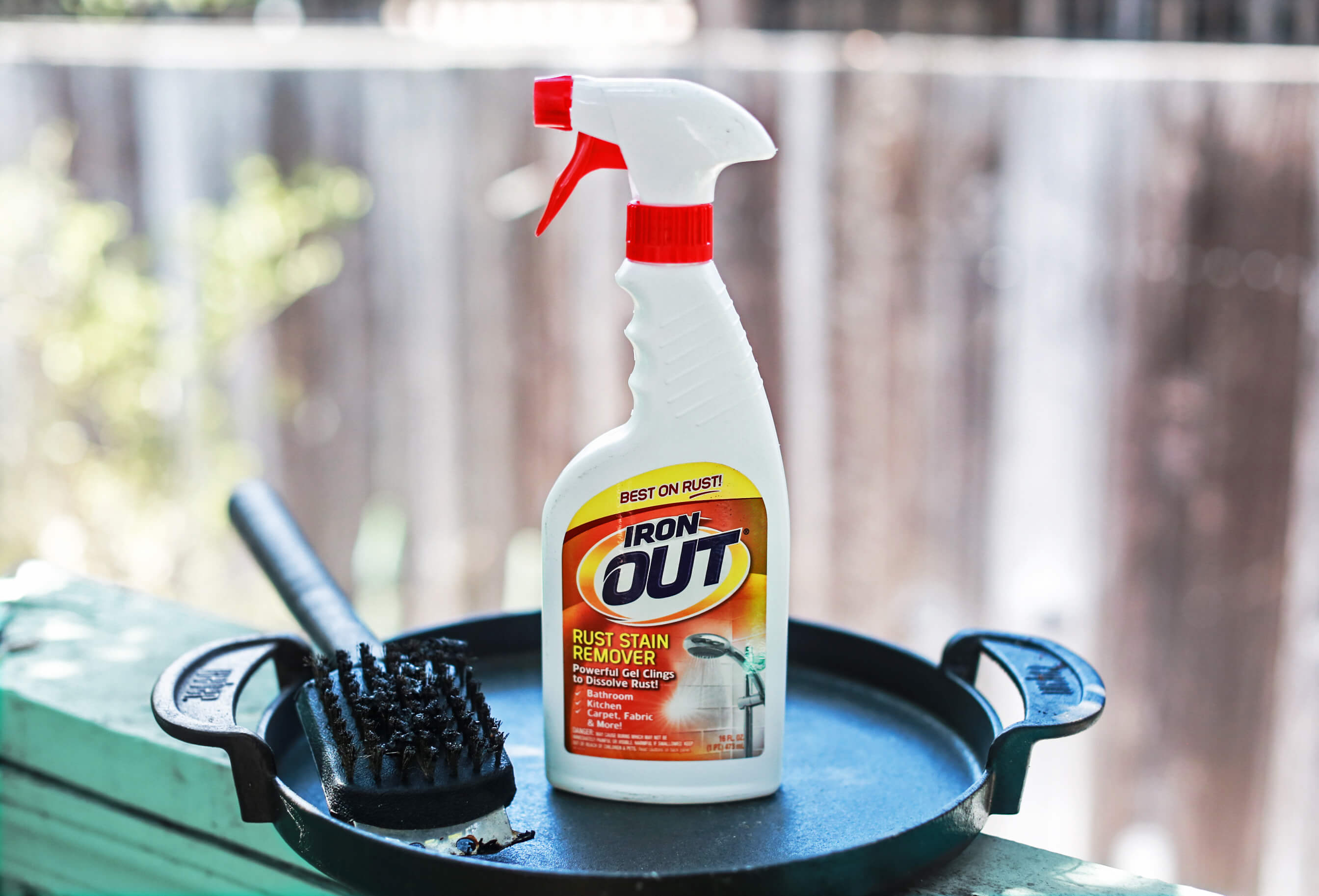
We were delighted to find that one of the spray products performed very well across the board. Iron Out – Stain Remover proved the best for a variety of surfaces, and it was particularly impressive at restoring our vintage chair’s chrome legs to almost showroom condition. It also quickly removed water stains from the door of our stainless steel refrigerator.
Iron Out’s packaging states that it’s specialized for bathroom, kitchen, carpet, and fabric stains, along with chrome and other surfaces. Combined with its stellar performance on chrome, we liked how Iron Out readily applies as a spray and wipes off after only a minute or two. With nearly 1,000 positive Amazon reviews, we were not alone in thinking that Iron Out is an excellent choice for a household rust remover.
With Iron Out, you get the best features of all our rust removers: simple application, speedy results, and the versatility to treat different surface types. Since it is a spray gel, Iron Out is simple to apply to vertical surfaces and does not drip excessively.
One slightly tricky thing about Iron Out is that the product instructions recommend wiping it off after a few seconds. In our experience, an application of between 60-90 seconds was optimal. It also helps to use a bit of elbow grease to achieve the best results. We obtained good results using it to remove rust stains on the front of a stainless steel refrigerator door, but we had to scrub vigorously and then leave the product applied for a minute or so.
Key takeaways:
- Iron Out sprayed on easily with very little overspray, and it was easy to wipe clean.
- It yielded positive results in a matter of minutes, as compared to some other products that require hours of treatment.
- Iron Out produces very little odor.
- We got spectacular results on the rusted chrome legs of a vintage chair.
Also great: CLR – Calcium Lime Rust Remover
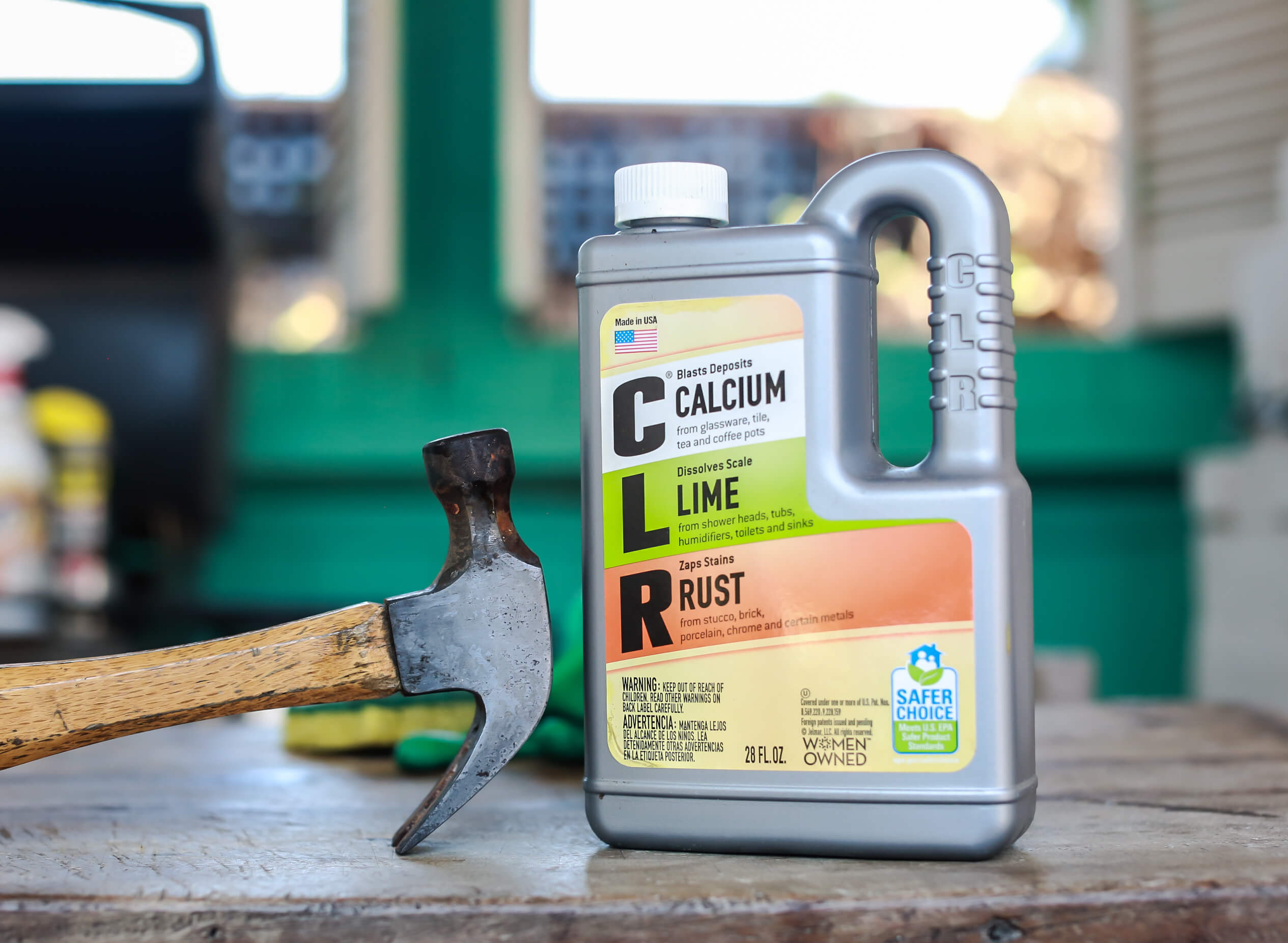
One thing to look out for with rust products is the manufacturer’s recommended uses. The word “rust” tends to be applied to a broad range of surfaces besides metal, including some surprising materials like fabric. We appreciated CLR – Calcium Lime Rust Remover quite a bit, as it comes in liquid form and can be diluted to the appropriate strength as required by the job.
It is recommended that CLR be diluted with 50-percent water, but it can be used full strength on more stubborn stains. For our tests, we used CLR at full strength. CLR proved a consistent performer. It worked best on nuts and bolts and shined up the front of our stainless steel refrigerator nearly as well as our top pick Iron Out – Stain Remover.
CLR is a product that is more appropriate for surface rust stains like those found inside toilet bowls, tile grout and the calcium deposits found on showerheads and faucets. We liked that it can be used full strength for items like nuts and bolts, but can also be diluted into a more household cleaner for appliances like the refrigerator we tested.
Also great: CLR - Calcium Lime Rust Remover
CLR proved to be a versatile rust cleaner that nicely addressed the entire range of applications we tested.It can be used for small household appliances like coffee pots or teakettles, and also on surfaces like tile, vinyl and concrete. We liked how easy it goes on and sponges off, and it works in a matter of minutes.
Another thing we like about CLR is that it is an EPA Safer Choice product, plus it has a pleasant citrus-like odor. CLR comes in liquid form and is packaged in a plastic jug. You need to transfer it to another container like a small plastic tub if you plan to dilute it or to apply it to a surface like a showerhead. If you use it full strength, you can simply use a sponge or rag and hold it to the mouth of the jug; but in our experience, CLR works best when the item can be fully submerged.
Like all of our tested products, CLR was easy to clean up with paper towels or a sponge, and it left little or no residue.
Key takeaways:
- CLR – Calcium Lime Rust Remover is Intended for rust stains on metal, concrete and other household surfaces.
- CLR can be applied either by submersion or surface application.
- You will typically want to dilute with water for ordinary stains, but it can also be applied full strength for tougher, hard-to-get-out stains.
- It does not contain oxalic acid or other harsh chemicals, and we found it to have a pleasant citrus odor.
- CLR is an EPA Safer Choice product.
Other products we tested
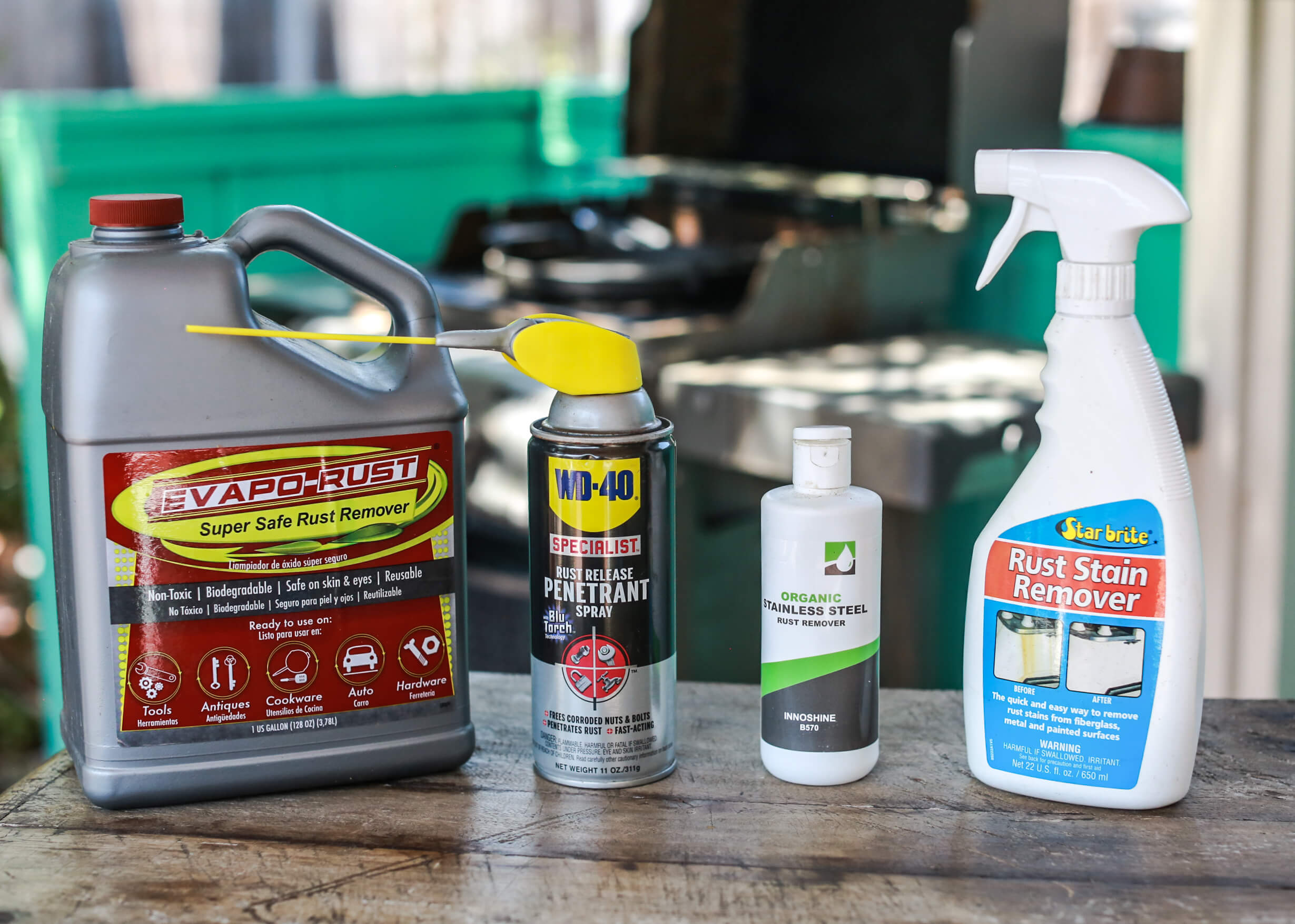
Aceros – Innosoft B570
Aceros – Innosoft B570 is something of a strange product. Touted as an “organic” rust remover, it contains sodium alkyl sulfonate, which can cause serious eye damage. In that sense, the “organic” label is misleading in that it suggests the product cannot be harmful.
Innosoft B570 is fairly simple to apply, but the surface should be horizontal since the gel can run down in a goopy mess if you’re not careful. For the more heavily rusted products we tested, such as our garden tools, Innosoft B570 didn’t quite have enough oomph to effect any change with a single application.
Evapo-Rust – Super Safe Rust Remover
Evapo-Rust – Super Safe Rust Remover is touted as an “amazing rust eliminator,” but it was just an average performer in our group, working best on our rusted weeding tool. It works best on items that can soak for the recommended one-to-twelve hours. On the plus side, Evapo-Rust is non-toxic, biodegradable, and does not contain any acids.
Star brite – Rust Stain Remover
Star brite – Rust Stain Remover is closer to an overall household cleaning product than a specialized rust remover. One of its principal uses is for cleaning fiberglass surfaces such as boats. In our testing, it worked decently on nuts and bolts and also performed fairly well at removing rust from our teapot. Star brite is a spray-on rust remover. While we did not have the chance to test Star brite on a boat, it is frequently mentioned in public forums as an effective boat cleaner.
WD-40 – Specialist Rust Release Penetrant Spray
WD-40 is a familiar brand to many people for its household lubricant spray. We tested its sister product WD-40 – Specialist Rust Release Penetrant Spray and loved how it can be applied in very tight spots. It worked incredibly well to stop a garage door from squeaking, and it aptly cleaned up our nuts and bolts, or even pruning shears. The drawback of this WD-40 product is that it cannot be conveniently applied to large rust patches or to irregular surfaces like teakettles.
If you’re looking to supplement a general-purpose rust remover with a product that specializes in loosening rusted nuts and bolts and eliminating squeaky hinges, then we highly recommend WD-40 – Specialist Rust Release Penetrant Spray.
How we selected
Rust is the common name for iron oxide, the combination of iron and oxygen expressed as chemical compound Fe2O3. The process of how rust works involves an electrochemical reaction involving an anode, cathode, and electrolyte. For those of you who skipped chemistry class, the first two are pieces of metal that give and receive electrons, and the last element is a liquid that helps the electrons move.
For our review, we began by identifying highly rated products from consumer and specialist sources and then screened product reviews for authenticity. We focused on rust removal products that are convenient to use, have a wide range of applications and minimize use of toxic chemicals. Our finalists were chosen based on three factors: the best for metal, the best spray, and the best liquid.
Of the three rust removal techniques — mechanical, conversion, and direct application — all of our products fall into the last category.
In very broad terms, household rust removers are designed to work in one or two simple applications. They can be divided into products that are intended exclusively for metal and products with a wider range of applications such as vinyl, ceramic tile, fiberglass, and even carpet and fabrics. We sought out the best representatives for both these categories.
How we tested
The first part of removing rust from household products is to assess the type of rust you’re dealing with. Stable rust and pitting rust are the most common forms found in a home. We tested our products on tools, surfaces, and appliances to determine the best overall performer.
All rust products, even the simplest spray-on products, require a reasonable amount of preparation to protect your hands and eyes. We tested a range of product types, including sprays, gels and liquids, and found ourselves liking the sprays the best for ease of applications.
After reviewing product instructions and optimal applications, we identified six products that provided a sufficient range of surfaces and types of rust. Not all products are created equal, so we targeted a minimum of four surfaces for each product. The six finalists can be broadly grouped into metal-specific products and nonmetal products for treating surfaces such as ceramic tile, vinyl and fiberglass.
Metal-focused rust removers:
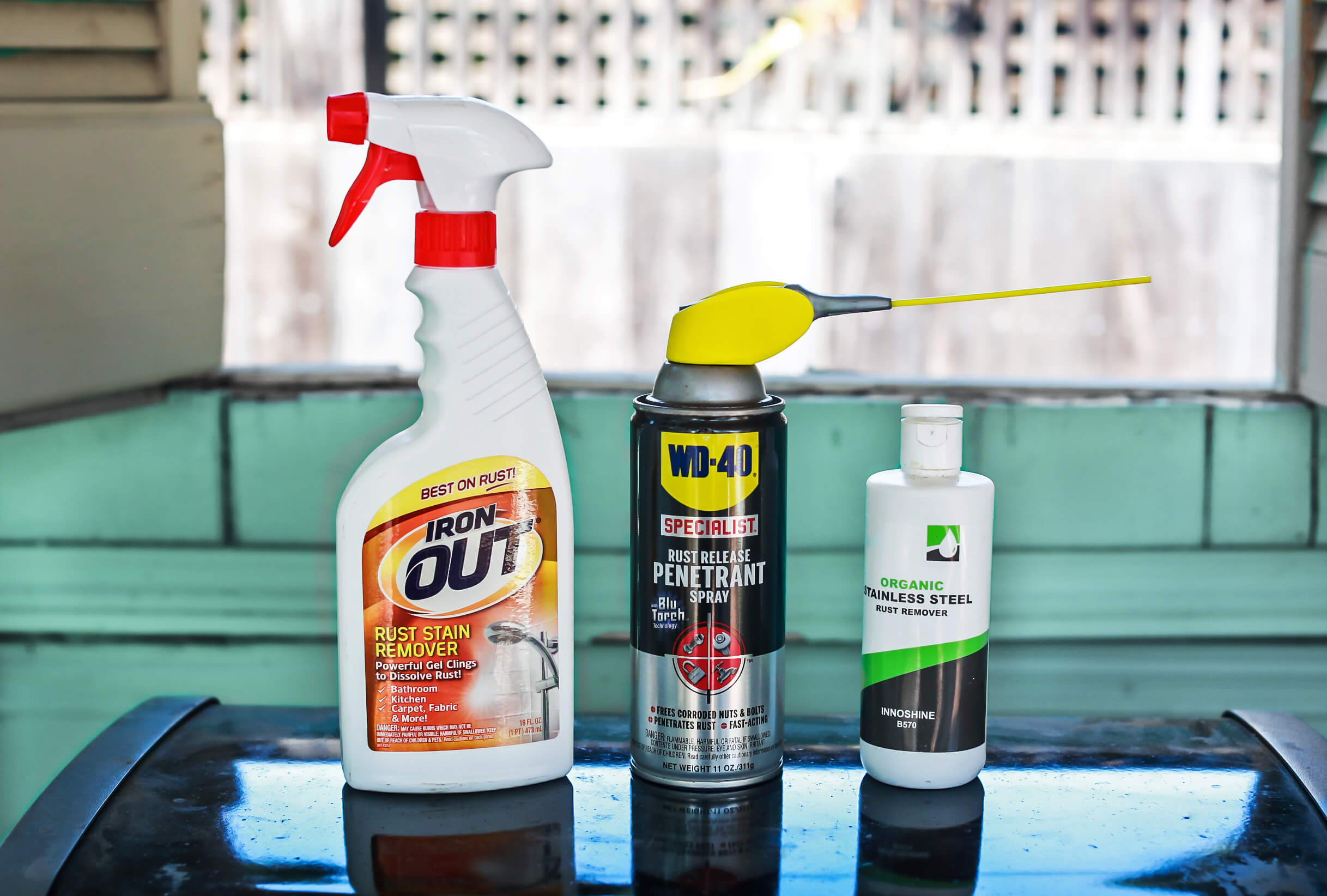
Aceros – Innosoft B570 : good for appliances and steel
Iron Out – Rust Stain Remover Spray Gel: good for fabric, tile, and tools
WD-40 – Specialist Rust Release Penetrant Spray : good for nuts, bolts, locks, and chains
All-around rust removers:
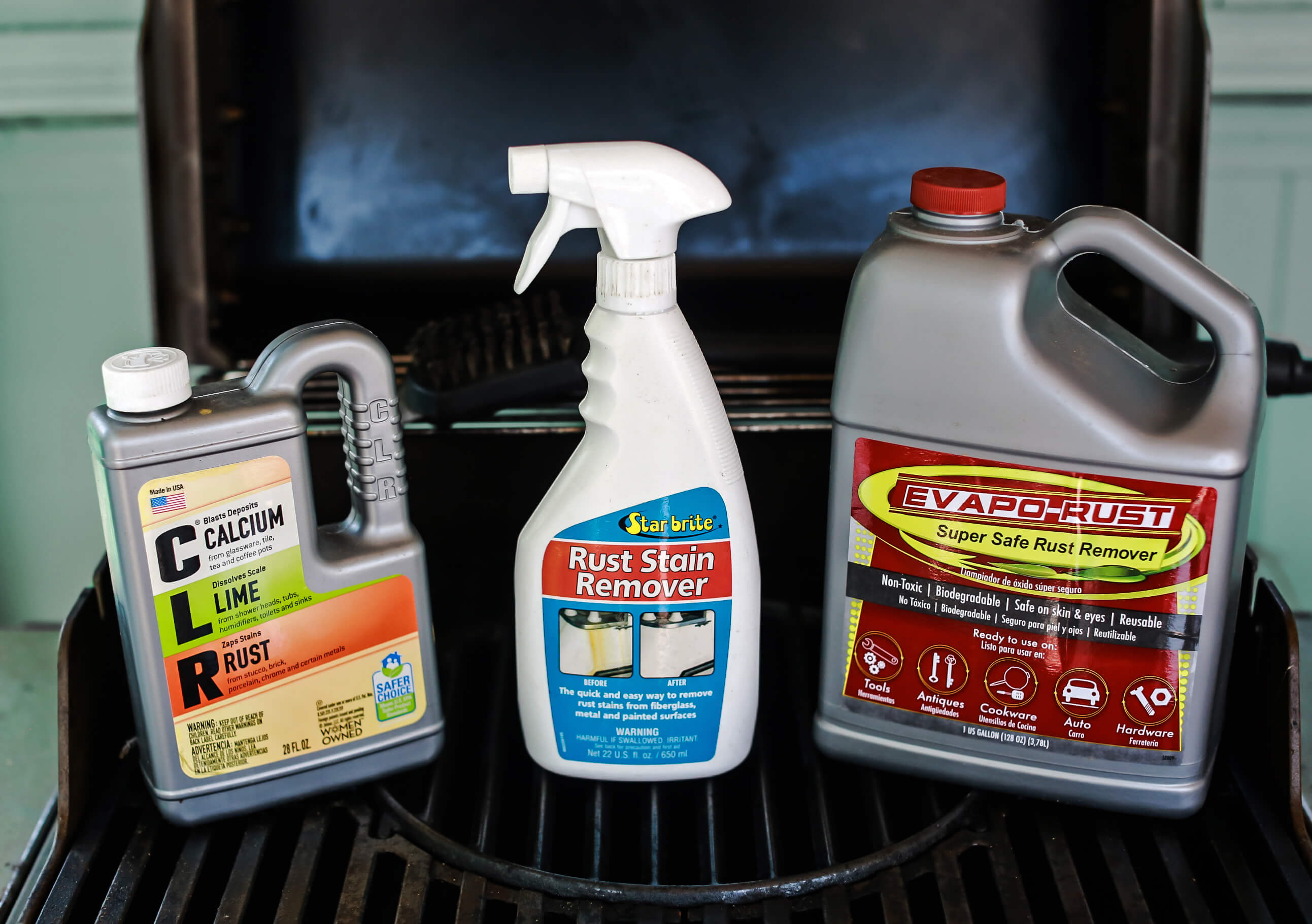
Star brite – Rust Stain Remover: good for fiberglass, vinyl, and metal
CLR – Calcium Lime Rust Remover: good for surfaces and appliances
Evapo-Rust – Super Safe Rust Remover: good for equipment, hardware, and tools
The test surfaces included the following:
- Steel work table (stable rust in patches)
- Garden tools (power washer nozzle, shovel, weeder, and rakes; included a mix of stable and pitting rust)
- Nuts and bolts (pitting rust)
- Teapots (water stains)
- Chrome chair legs (stable rust)
- Stainless steel refrigerator (water stains)
The products were applied according to instructions. Where a range of application times was given, we used the midpoint time. Where possible — for example, on the work table — we applied simultaneously multiple products to compare performance. For other rusted objects, such as workshop tools, we applied each rust remover separately.
Outdoor furniture and tools
Old tools never die, they are just left outside to rust. Rust and associated stains can be found everywhere: Tools, surfaces, bikes, cars, and furniture are common victims. Most rust is treatable to some extent, and fortunately, there are excellent household products to help get the job done.
Our steel work table presented the biggest challenge. None of the four products we tested on the table did an effective job in cleaning the table legs. Even Evapo-Rust – Super Safe Rust Remover, which was left applied overnight, did not have much of an impact on the table legs (other than to darken them somewhat).
The table was our most “industrial” representative with heavy-gauge steel and a painted surface that was likely applied electrostatically. Heavy-duty products with painted or coated surfaces will typically require a two-step approach that requires removing the finished surface first and then applying the rust remover. We tested our products on the table to see if they would improve the overall rusted appearance without it turning into a major project.
Our garden-tool category was a bit of a mixed bag. We used four tools with stable and pitting rust: a shovel, a weeder, and two rakes. The Evaporust, probably due to it being a liquid for which total immersion is possible, took most of the rust off the weeder’s tip after it was partially immersed in a bucket. We also applied Aceros – Innosoft B570 to our rusted shovel with a wet sponge as recommended. It did a credible job of cleaning the rust from the shovel and giving it an overall darkened appearance.
One area where all our finalists “shined” was removing pitted rust off nuts and bolts. With very small objects, complete immersion is quite practical. We saturated paper towels and then rinsed and wiped down the nuts and bolts. While all the products did an excellent job, the WD-40 – Specialist Rust Release Penetrant Spray was perhaps a bit better, pretty much as we’d expected from a product that touts nuts and bolts as a specialty.
Our two rakes were so heavily rusted that it was hard work for the two products we tested on them, CLR and Iron Out. Both products darkened the rakes, but the metal remained rusty. CLR, which we applied at full strength, narrowly outperformed Iron Out on this test.
Indoor appliances and housewares
Moving indoors, we tested our products on common appliances: a refrigerator, a stainless steel tea kettle, and a steel pour-over kettle. For the refrigerator, we selected the four products that matched the assignment: Innosoft, Iron Out, CLR, and Star brite. We divided a zone of the water-stained refrigerator door into four distinct areas and applied our products per manufacturer instructions.
Once again, Iron Out – Rust Stain Remover Spray Gel performed the best, bringing back a nice shiny surface and removing the water stains almost entirely. CLR – Calcium Lime Rust Remover also did an excellent job polishing out the water stains.
We then checked back in 48 hours to see if there was any “ghosting” or residual markings where the original stains had occurred. The presence of such marks would suggest that the rust-removal products had worked topically but had not penetrated the surface. Very little ghosting was evident from the sections treated with Iron Out and CLR. Star brite, and Innosoft also worked fairly well on the refrigerator but did not quite restore the shine as much as the other two products.
=”Lineup of rust removers on wood” width=”2619″ height=”1805″ />
| Product | Cost | Primary Use | Form |
|---|---|---|---|
| 1. Iron Out | $ | Bathrooms, kitchens, appliances, laundry, and water softener maintenance | Spray Gel |
| 2. CLR | $ | Calcium, lime and rust stains | Spray |
| 3. Aceros | $$$ | Stainless steel and appliances | Liquid |
| 4. Evapo-Rust | $$$ | Tools, antiques, and cookware | Liquid |
| 5. Star brite | $$ | Fiberglass, Vinyl, Metal and Painted Surfaces | Spray |
| 6. WD-40 | $ | All purpose | Spray |
Types of rust
While rust conditions might all look alike to the untrained eye, there are subtle differences in the nature of how rust occurs, even within the confines of a small tool like a wood plane. An ideal sample of different types of rust includes four variations: stable rust, flash rust, flaking rust, and pitting.
Stable rust: Occurs over long periods of time and tends to be uniform in appearance. In certain cases, like uncoated steel building panels, stable rust is considered to be a desirable aesthetic effect.
Flash rust: Results from water occurring at one spot. Flash rust is frequently bright orange in color and can occur in as little as six hours.
Flaking rust: Can actually take up more volume than the metal it displaces and is often found in transitional areas where a coating ends.
Pitting: Results from trapped moisture and is commonly found in the cavity areas of tools and furniture.
Common methods for removal
Rust removal is a broad topic that includes a wide range of techniques for cleaning metal and other materials where surfaces have become tarnished, stained, and tainted with oxidized metal (aka rust). Dealing with rusted metal objects and surfaces can be addressed with three basic techniques:
Mechanical methods: Grinding, sanding, and scouring.
Conversion methods: Preventing the further spread of rust by using chemical solutions to convert the rust into a protective barrier.
Direct application: Soaking, spraying, or wiping a removal product onto the surface.
In addition to metal, the word “rust” is commonly used to describe discoloration from hard-water stains and reactive stains that appear on nonmetallic surfaces such as porcelain, stone, wood, brick, concrete, fiberglass, and vinyl. The rusty stains in bathtubs and toilets are common examples of nonmetallic rust.
The reality of rust is that it is tricky to figure out. Many household items have patches of rust intermingled with painted or other coatings. This was the case with the steel table that we tested. It had painted legs with the paint worn off in patches and with rust in-between. Our overall experience with the four (only four of our six were used on the table) rust removal products was that most of them darkened the rusted area but did not affect the paint. For heavy-duty cases like this, a more labor-intensive process using a paint stripper and/or a chemical rust remover is required.
Important features to consider
Home rust removers are packaged and applied in a variety of ways. The most common applications are sprays, gels, and liquid (i.e., immersion) forms. Apart from considering the effectiveness of the product in question, we also delved into the features that consumers find most important.
Form of application: Rust-removal products come in spray, gel, and immersion form. The most convenient products are those that can be sprayed on the rust. Although spray-on application is easy, it can still be tricky knowing how much spray to use — but here’s a tip: The position of the rusted item is important. If you are spraying a vertical surface, the spray drips down the face, and it can be difficult to apply the product evenly. The best way to deal with this is to spray just a bit at a time and work it in as you go.
Toxicity: This was a key consideration in our product selection. Toxicity relates to both the impact on the individual applying the product and to the disposal of the product in the environment. We avoided products with oxalic acid, a comparatively abrasive and harmful chemical. Instead, we focused on products that did not require respirators and special handling, although we did use gloves to avoid direct contact with the skin during application (and we recommend that you do too). Some products, like Iron Out – Rust Remover, warn that burns can occur that might not immediately be felt. It is advisable that extra care be taken when using any rust-removal product.
Odor: Most of the products we tested had a fairly mild odor or no odor at all. If you are sensitive to odors, it is advisable to wear a respirator and safety glasses when applying rust removers. Since the products we tested were selected in part for being relatively environmental-friendly and nontoxic, none of the manufacturers recommended wearing a respirator during application.
Duration of application: The recommended time for application is noted on all products. For some products, there is a different prescribed time that depends on the severity of the rust and the type of surface treated. Of the products we tested, Evapo-Rust – Super Safe Rust Remover had the widest range of recommended application times.
Effectiveness based on a single application: For household use, a single application is desirable. Since even the simplest application of a rust remover entails a certain amount of care, mess, and clean-up, no one wants to go through multiple applications to achieve a good result unless it’s absolutely necessary.
The bottom line
An easy-to-use, nontoxic rust remover is a great item to have around the house to help with everything from unsticking locks, to improving the appearance of tools and equipment, to restoring metal and other surfaces to almost new condition. We tested six rust removers in gel, liquid, and spray form to determine ease of application and effectiveness of results.
Our favorite overall product was Iron Out – Rust Stain Remover Spray Gel, which worked extremely well on a rusty steel refrigerator door, a teakettle, as well as nuts and bolts. Another incredibly convenient product, WD-40 – Specialist Rust Release Penetrant Spray has a long nozzle designed to penetrate rusty tool parts and locks that need to be freed up. We think keeping both of these fairly inexpensive products around is a great idea.
The runner-up was CLR – Calcium Lime Rust Remover, which is effective on a variety of surfaces. However, as a liquid, CLR can be more difficult to apply than a spray, gel or spray gel, especially to vertical surfaces where it will drip down.
More Reviews
The 9 Best Mops For Hardwood Floors
Rubbermaid - Reveal Spray Mop
DELOMO - Pet Hair Roller
SimpleHuman
The 8 Best Vacuums for Hardwood Floors
Shark - Apex
Shark - Rocket HV302
Shark - Apex
Cottonelle - Ultra ComfortCare
The 7 Best Mops For Laminate Floors
O-Cedar ProMist MAX
CatGuru - Heavy Duty Cat Litter Mat


